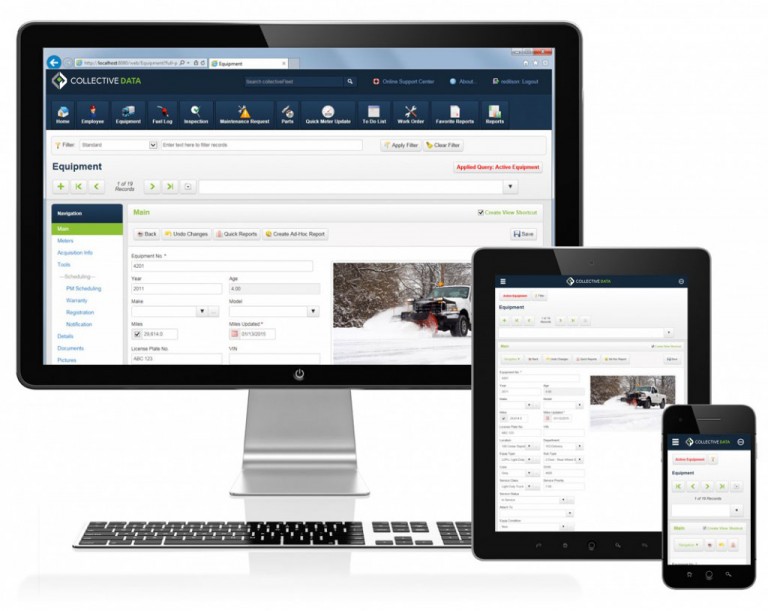
Collective Data has evolved into three main products available on any internet-connected device. IMAGE COLLECTIVE DATA
By Dave DeWitte
dave@corridorbusiness.com
Customers keep finding more uses for Collective Data, a family of flexible database products developed in the Corridor that are used by clients to track and maintain everything from truck parts to Tasers.
“Businesses and government agencies once kept track of their vehicle fleets and inventories on paper-based systems, and as technology evolved, spreadsheets,” explained CEO Jason Wonase.
The Cedar Rapids-based company started about 20 years ago by bringing the power of modern database software to bear on customers’ problems and making it easy to use on multiple devices.
Fleet managers were the original customers. They included organizations such as public works departments and transit authorities with hundreds of pieces of equipment. Not only did they need to keep track of what was in their fleets, but things like how many parts they had in stock to service them.
The Collective Data platform today does much more, however. It provides users with alerts when it’s time to bring in a vehicle for service such as oil or tire changes, or when a warranty expiration is looming, potentially saving thousands of dollars. It can also provide a window into patterns in data that can generate even more savings and reduce failures.
“It keeps track of recalls, even implements awareness for traffic violations,” Mr. Wonase said. “You could see this driver’s had three accidents in the last two years.”
Over the years, Collective Data has evolved into three main products: Collective Gov, an asset management system focused on the needs of government users; Collective Fleet, software that tracks things like work orders, inspections and repair records; and Collective Quartermaster, a supply and inventory management system for law enforcement agencies.

The company’s developers are continuously improving those products. A big shift in recent years has been away from a Windows-based product to a cloud-based platform that can be accessed from virtually any device with an internet connection.
“Our biggest and most important investment is in making our stuff browser-based, so we can be cloud accessible,” Mr. Wonase said. “We started in late 2012, and in the last four or five years have been based on that.”
One recent adopter of Collective Data in the Corridor is Iowa Northern Railway, a regional short-line railroad based in Cedar Rapids. Three of the company’s departments are transitioning to Collective Data’s platform from more basic software, and even a paper-based, fax-in system, explained Matt Hoover, the railroad’s IT manager.
Its mechanical department, which maintains locomotives, will use it to keep track of maintenance needs and inventory.
“The idea is to have a history on that equipment,” Mr. Hoover said. “Every so many years, we have to overhaul them. We’ll be able to say, ‘we spent this much on this one – it’s obvious that it’s time to get it overhauled, and not that one over there that’s been running well.’”
Another department will use it to keep track of the maintenance needs and condition of railroad track itself. A third will use it to keep track of road maintained by the railroad, which is now done on paper.
“They’ve got a nice little product,” Mr. Hoover added. “Their bread and butter was vehicle maintenance, and their product does way more than that. However, we will use it for our dump trucks and road graders.”
Public safety agencies have been one of the fastest growing markets for Collective Data, as they strive to become more efficient at tracking and maintaining valuable inventories such as body cameras, police radios and even uniforms. The company recently expanded its reach in the market by acquiring Quartermaster Solutions, a product that competed with Collective Quartermaster.
“Now we’re getting into cities we never would have been in,” Mr. Wonase said. Although the Quartermaster products are designed for the specialized needs of law enforcement, he said the benefits of Collective Data products to one department of a customer are often realized by other departments, resulting in more business opportunities.
The company has four software developers dedicated to development on the software platform, and seven who work with clients to configure the application to their specific needs. Training clients on the software usually takes a day or two, and the cost – based on the number of users – typically ranges from the tens of thousands to more than $100,000.
A potential opportunity for expanding the utility of Collective Data’s products is in the growing area of predictive analytics. Software tools may be added to the package that can use the data already collected to provide insights into a broad spectrum of decisions, such as when to lease or buy equipment and the optimal level of maintenance for return on investment. Talks are underway with a third-party vendor about adding the capabilities, Mr. Wonase said.
About a year ago, Collective Data became one of the first businesses to locate in The Depot, a large mixed-use development in Cedar Rapids’ New Bohemia district. The company’s new 12,700-square-foot space is designed to help the company compete in the race for talent, with amenities like a gym, collaboration spaces and a choice of stand-up or sit-down workstations. Located right across the street from Vault Co-Working and the Iowa Startup Accelerator, it also places the company at the heart of the city’s burgeoning startup scene.
As it expands, Collective Data will keep building better products, Mr. Wonase said. But sometimes, it’s more about doing the simple things right than adding that next feature or two that some users might want.
Without a product like Collective Data, Mr. Wonase said clients can spend a lot of time running around piecing together bits of information to justify decisions like when to request funds for a new sanitation or fire truck. With the platform, the decisions almost make themselves.
“At the end of the day, a big part of it is just being able to manage the budget,” he said.




